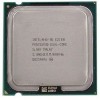Intel E2180 Design Guide - Page 119
Table, 5. Balanced Technology Extended BTX Fan Speed Control Settings
 |
UPC - 683728169121
View all Intel E2180 manuals
Add to My Manuals
Save this manual to your list of manuals |
Page 119 highlights
Legacy Fan Speed Control Table 7-5. Balanced Technology Extended (BTX) Fan Speed Control Settings Parameter Classification Processor Thermal Sensor System Ambient Sensor PWM Output Notes THIGH TLOW Minimum PWM Duty Cycle PWM Frequency Spin Up Time TAVERAGING When TSENSOR < TLOW All Fans On Hysteresis Offset Required Required Required Required Suggested Suggested Suggested Suggested Suggested Required TCONTROL TCONTROL - 7 °C 4.0 sec Minimum PWM% TCONTROL + 3 °C 2 °C Thermal Diode Correction Factor 54 °C 47 °C 4.0 sec Minimum PWM% 65 °C 4 °C PWM 1 (TMA) - 20% 21-28 kHz 250 - ~ 500 ms 3,5,9 3,5,9 1 2, 7 3, 7 8,9 NOTES: 1. A PWM frequency of 25 kHz is the design target for the reference and for the Intel® Boxed Processor and BTX reference design. 2. Use the lowest time available in this range for the device selected. 3. TAVERAGING = represents the amount of delay time before responding to the temperature change, defined in fan speed control device (sometimes called ramp range control or spike smoothing). Select the lowest setting available close to 4.0 seconds by the fan speed control device. 4. The Fan Speed Controller, or Health Monitor Component, takes the result of the two fan speed ramps (processor and system) and drives the TMA fan to the highest resulting PWM duty cycle (%). 5. For BTX systems a second thermal sensor is recommended to capture chassis ambient for more detail see Appendix F. 6. To ensure compliance with the thermal specification, thermal profile and usage of the TSENSOR for fan speed control these setting should not be user configurable. 7. If this function is present on the device, it must be enabled. 8. If present in the FSC device, the Thermal Diode Correction Factor should be input to this register. 9. If the FSC device does not have a means to input a fixed temperature offset then: THIGH = TCONTROL + Thermal Diode Correction Factor and TLOW = TCONTROL + Thermal Diode Correction Factor. Note: The fan speed component vendors provide libraries that are used by the BIOS writer to program the component registers with the parameters listed above. Consult the appropriate vendor datasheet for detailed information on programming their component. § Thermal and Mechanical Design Guidelines 119















